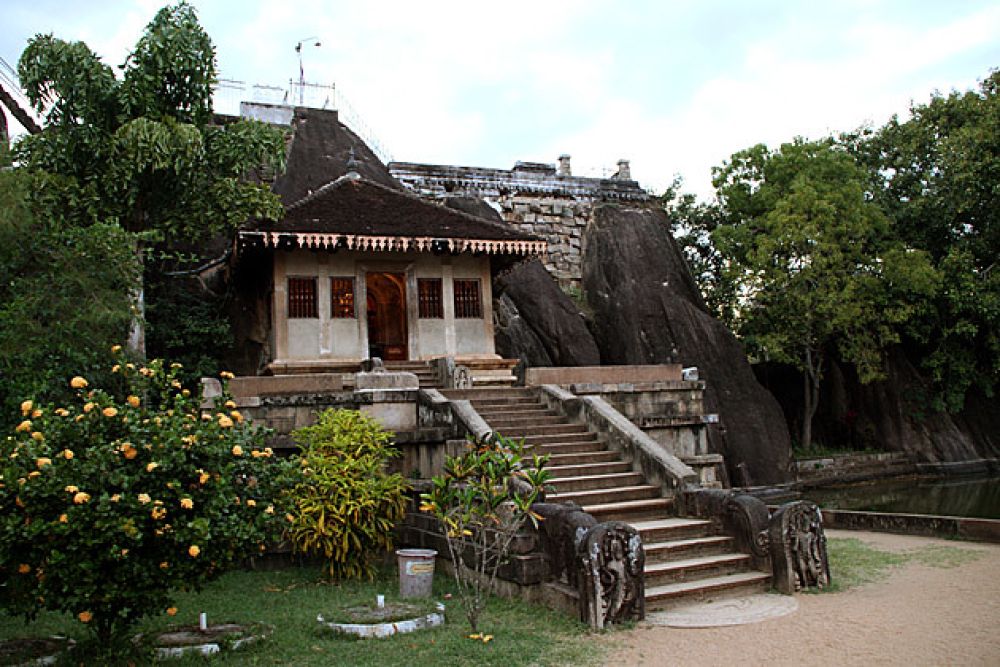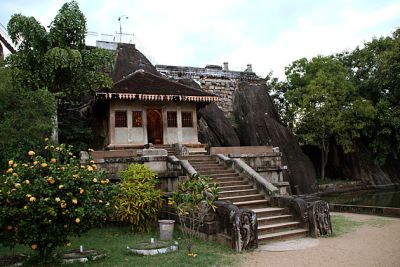

Isurumuniya Temple is a significant Buddhist temple located in Anuradhapura, Sri Lanka, renowned for its rock carvings and historical value. The temple, dating back to the reign of King Devanampiya Tissa (307–267 BCE), holds a crucial role in the local Buddhist culture. Visitors can explore the serene premises, which are home to a vihara (Buddhist monastery), a stupa, and the famous Isurumuniya Lovers sculpture, depicting a man and a woman in a graceful embrace, which is believed to be an illustration of a royal couple. The temple complex also includes the Royal Family sculpture and intricate carvings of elephants in the Elephant Pond. Tourists can take a reflective walk through the temple's captivating gardens, examine the historic stone carvings, and immerse themselves in the tranquility of the Buddhist chants echoing through the air. The enchanting view of the Tissa Wewa tank from the temple adds a picturesque backdrop to the site.
Delve into the historical essence of Isurumuniya Temple by taking a close look at its ancient rock carvings, which are masterpieces of early Sri Lankan art. The most celebrated of these is the 'Isurumuniya Lovers' carving, believed to be over a thousand years old, giving insight into the aesthetic values and craftsmanship of ancient Ceylon. Additionally, the 'Vatadage' carvings – circular relic houses adorned with detailed designs, offer a compelling exploration for history buffs. These carvings reflect the influence of early Buddhist and Hindu cultures on the island. Visitors get the chance to witness the intricate workmanship that has withstood the ravages of time, as well as learn about the symbolism and significance of each carving from knowledgeable local guides.
The Elephant Pond (Eth Pokuna) at Isurumuniya Temple is a prominent feature that deserves special attention. This man-made pond receives water from the Tissa Wewa and is surrounded by the famous elephant carvings. Visitors can capture the grandeur of these stone elephants, which seem to be playfully emerging from the water. These images present a timeless bond between nature and the creativity of ancient artisans. Photography enthusiasts will find plenty of opportune moments to click the perfect shot during the golden hours of dawn or dusk when the soft sunlight complements the deep greens of the surroundings and the textural intricacies of the carvings.
The tranquil environment of Isurumuniya Temple offers the perfect setting for meditation and spiritual reflection. Visitors can participate in guided meditation sessions organized within the temple premises, where they are led by experienced practitioners. Sitting in the serene backdrop with the gentle sounds of nature and chanting in the distance, participants can learn various meditation techniques, such as mindfulness and loving-kindness (Metta) meditation, rooted in Buddhist traditions. These sessions aim to promote inner peace, foster self-awareness, and provide respite from the hustle of daily life. For those seeking a spiritual journey, this activity delivers a profound experience that can have beneficial effects on mental well-being.
Curious minds looking to understand the rich historical tapestry of Isurumuniya Temple can partake in lecture tours. These tours are led by scholarly guides proficient in the temple's history and its significance in Sri Lankan culture. The narrative encompasses tales of kings who ruled the era, the arrival of Buddhism to the island, and the temple's role through centuries. Tourists will be ushered through various temple parts, including the stupa, the Bodhi tree, and ancient bathing pools, whilst unraveling the lore and legends that surround this sacred site. Suitable for history enthusiasts and cultural tourists alike, this immersive experience provides a deeper comprehension of the historical and religious intricacies of Isurumuniya Temple.
One of the most immersive experiences at Isurumunija Temple is participating in authentic Buddhist rituals. These can range from simple offerings of flowers and incense to observing and joining in the Poya days' special ceremonies, which occur on the full moon of each month and hold particular significance in Sri Lankan Buddhism. Tourists can watch or take part in the lighting of oil lamps, chanting of Pirith (Buddhist scriptures), and the offering of Dana (alms to the monks). Engaging in these traditional practices offers a unique opportunity to understand and respect the local customs and spiritual practices, providing visitors with a profound and personal connection to the place and its religious heritage.
The temple’s elevated position beside the Tissa Wewa offers breathtaking views of the sunrise and sunset over the ancient city. Watching the dawn break over the stupa and vihara, or the dusk calming the waters of the reservoir, are moments of sheer beauty that should not be missed. Visitors during these times will be treated to a natural spectacle as the sky shifts through a palette of vibrant colors, reflecting over the water and the temple's ancient structures. This activity does not require a structured plan and thus, rewards early risers and twilight admirers with a tranquil start or end to their day, complemented by the harmonic chanting of monks from the temple.
For a more hands-on experience, Isurumuniya Temple occasionally hosts cultural workshops where visitors can learn about Sri Lankan arts and crafts, traditional music, dance, and even some aspects of Buddhist philosophy and meditation. These workshops are conducted by local artisans, dancers, musicians, and monks who are keen to share their knowledge and skills. Whether it's trying your hand at local crafts, gaining insight into the instruments and rhythms of traditional Kandyan music, or getting an introduction to the graceful movements of Sri Lankan dance forms, these workshops offer a participatory peek into the diverse cultural fabric of Sri Lanka.
Isurumuniya Temple is part of the larger Anuradhapura archaeological park, which is littered with ruins and relics of a kingdom that thrived over a millennium ago. Visitors interested in the exploration of these ruins can venture beyond the temple to discover other archaeological wonders scattered across the ancient city. From well-preserved dagobas (domed structures that house relics), palaces, pools, to monastic complexes, there is a wealth of history waiting to be explored. Learning about the archaeological methods and conservation efforts can also enhance the visitor's appreciation of how the past is kept alive and relevant in modern times.
Isurumuniya Temple often sees an influx of pilgrims, especially during religious festivals and Poya Days. Engaging in a pilgrimage program can offer a structured spiritual journey through various Anuradhapura religious sites, culminating at the Isurumuniya Temple. Pilgrims can observe and partake in rituals, listen to sermons from monks, and gain a deeper understanding of the teachings of Buddhism. These programs might include visits to other sacred sites such as the Sri Maha Bodhi Tree and Ruwanwelisaya stupa, providing a comprehensive pilgrimage experience that offers both enlightenment and a sense of peace.
